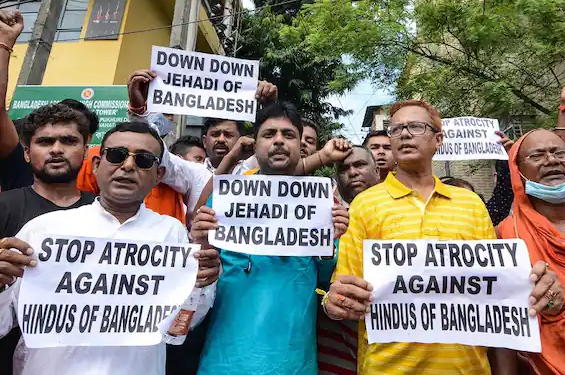What has been happening in Bangladesh since the commencement of Durga Puja was only waiting to happen following the takeover of Afghanistan by the Taliban. The day the religious bigots captured Kabul and the Afghanistan government abjectly surrendered to them, it was clear to the international community that Moslem fanatics across the globe would regroup and advance their skewed religious-political agenda. What is surprising is that the zealots, as a Bangladesh minister has identified the mastermind of the frenzy in the country, could strike so early when the Taliban are still trying to get legitimacy of their rule through international recognition. Though the Bangladesh government has acted fast and taken steps to douse communal passion, it is rather strange that there was apparently no intelligence feedback about such a backlash. Already five people belonging to the Hindoo minority population have lost their lives, over a hundred sustained injuries and reports of homes being ransacked and molestation are pouring in. In the context of the Taliban’s re-emergence, it was only natural for a credible administration in the subcontinent to be extra cautious during religious festivals involving millions of people such as Durga Puja. Obviously, the Bangladesh government was caught unaware that a conflagration of such magnitude would be engineered by vested interests “with foreign links”.
Now, the Bangladesh administration has deployed paramilitary forces in 34 of 64 districts, which only shows how the perpetrators widened their network before orchestrating the communal violence. According to one report, the incident of alleged sacrilege in Cumilla that triggered the frenzied attacks was the handiwork of zealots who sneaked into a puja pandal when the security guard was asleep, did the mischief, took a photograph and made the image viral. Bangladeshi media reported that on October 17 alone, at least 20 homes belonging to Hindoos were torched in Rangpur city’s Pirganj neighbourhood. Tension in the area mounted following allegations that a Facebook post of a man belonging to the minority population hurt majority sentiments. The incident occurred a day after some 10,000 protesters – many of them carrying banners of Islamist political parties – took to the streets outside Dhaka’s main mosque. The crowd chanted “Down with the enemies of Islam” and “Hang the culprits”.
Temples in Chandpur’s Hajiganj, Chittagong’s Banshkhali, Chapainawabganj’s Shibganj and Cox’s Bazar’s Pekua were attacked and Hindoo devotees thrashed. According to a spokesman of the minority population, at least 80 makeshift temples had been attacked. Bangladesh Prime Minister Sheikh Hasina met leaders of the Hindoo community and assured them that no one, whatever his/her religious affiliation, would be spared and the culprits would be “hunted down.” These are reassuring words indeed as is her exhortation to the Indian government to make sure nothing happens on this side of the border that may strengthen the hands of the trouble-makers in her country. Her Information and Broadcasting Minister Hasan Mahmud said the trouble had been engineered by the Jamaat-e-Islami with support from the Opposition Bangladesh Nationalist Party (BNP). He also hinted at a foreign hand.
In the port city of Chittagong, the Bangladesh Hindu Buddhist Christian Unity Council has announced a sit-in and hunger strike from October 23 in protest against the attacks on Hindoos. The protests will take place at Dhaka’s Shahbagh that became an iconic venue for mass movement in the recent past, and Chittagong’s Andarkilla. A six-hour bandh was observed by this organisation in Chittagong October 17.
The speed with which the communal frenzy was organised does indicate a well planned strategy. Whether there was a ‘foreign hand’, as alleged by a minister of the Bangladesh government, is difficult to ascertain. However, it is not difficult to understand that the reference of ‘foreign hand’ being made is to Pakistan, which has aided and abetted the Taliban for the past two decades to regroup and finally capture Afghanistan. By creating religious disturbance causing a serious law and order problem in Bangladesh, Pakistan would be like killing two birds – India and Bangladesh, as Prime Minister Sheikh Hasina has good relationship with the Indian government – with one stone. It has long been nursing the wounds of the formation of Bangladesh carved out of its eastern territory. Sheikh Hasina
and her Awami League are stumbling blocks to its goal of propping up a puppet government in Bangladesh. The emergence of the Taliban has come as a boon for Pakistan as Islamist groups in Bangladesh have got a shot in their arm. The current communal attacks are the first tell-tale manifestation of this design.
The Government of India has to take careful note of the change in the atmosphere all around the neighbourhood. A casual glance at a map of Asia will show to anybody who cares to see that there are no friendly nations around us anymore. The only non-Moslem nations on our borders namely Bhutan, Sri Lanka, Myanmar and Nepal have all entered into deep pacts with China. Seemingly, on the surface, their relation with China is primarily economic but when scrutinized properly, all of them turn out as strong military-economic packages. Therefore it can be stated that India’s internal politics has now gathered international ramifications. Apart from garnering votes for temporary political successes, India’s present day leadership and the politics they play out, based on hate and persecution, seems to have had an undesirable impact on foreign policy that could take decades to shake off. Only time will tell how deep the wounds run.






































